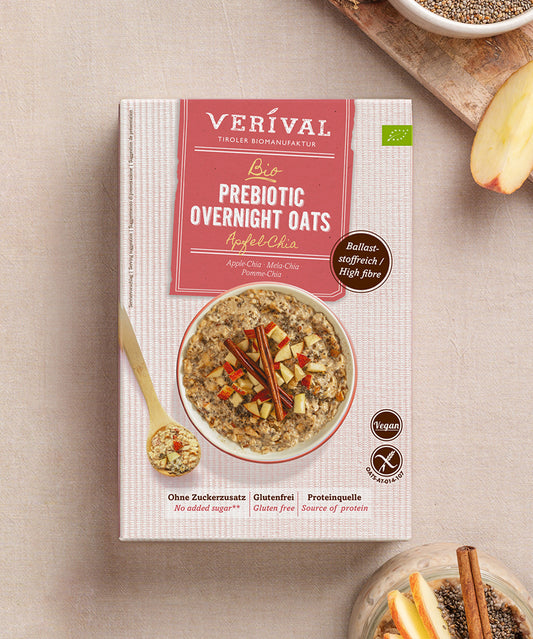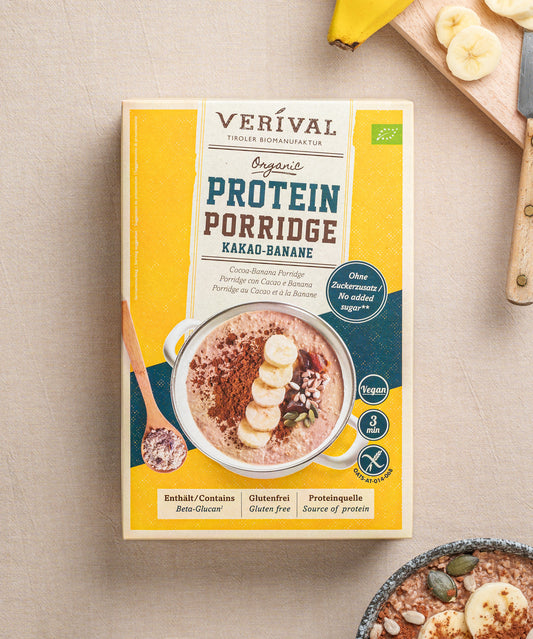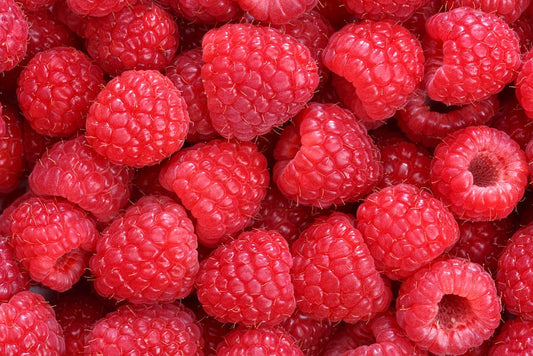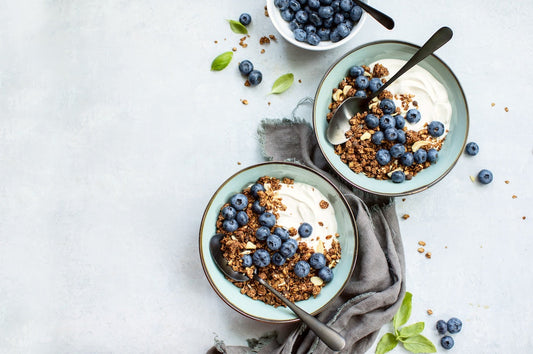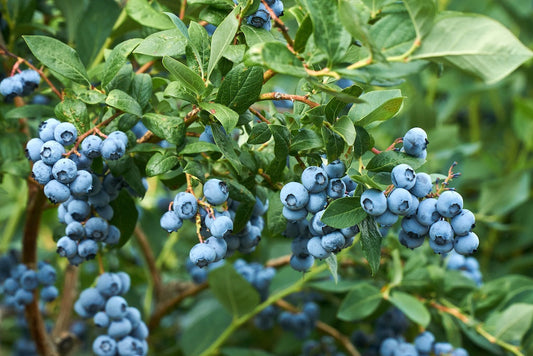Diabetes. For many, this is initially a shock diagnosis, because the disease diabetes mellitus is associated with insulin, a sugar-free diet and strict blood sugar controls.
The worst thing for many is the feared loss of quality of life, because suddenly everything that tastes good seems unsuitable for diabetics. But is that really the case?
Do I suddenly have to give up everything that contains starch, sugar or carbohydrates in general because of my diagnosis? The answer is no!
Today, we want to dispel a few of the nutritional myths surrounding diabetes and show you what great alternatives are out there and how it is even possible to lower your blood sugar level naturally with the right foods. A healthy breakfast could help.
What can trigger diabetes?
Diabetes is not a disease that suddenly appears out of nowhere. At least not most of the time. There are two types of diabetes: type 1 and type 2. Both types show similar symptoms and progressions, but differ in terms of their cause.
Type 1 diabetes
People with type 1 diabetes suffer from an autoimmune disease that causes the beta cells of the pancreas to stop producing insulin. This defect is usually congenital and requires a permanent supply of insulin.
Type 2 diabetes
Type 2 diabetes is often the result of overeating and being overweight. The condition is also known as “adult onset diabetes.” However, for some years now, more and more children and adolescents have been developing diabetes, which is due to an excessive intake of sugar, fat and salt in the diet.
The amazing thing is that type 2 diabetes can be reversed with a healthy diet and exercise!
Blood sugar levels – what is normal?
| Blood sugar (fasting) | Blood sugar (2h after eating) | |
| Normal value (adults) | 100 mg/dL (5.6 mmol/L) | 140 mg/dL (7.8 mmol/L) |
| Precursor to diabetes | ≥ 100 mg/dL (5.6 mmol/L) | ≥ 140 mg/dL (7.8 mmol/L) |
| Diabetes mellitus | ≥ 110 mg/dL (6.1 mmol/L) | ≥ 200mg/dL (11.1 mmol/L) |
Source: Lexikon der Krankheiten und Untersuchungen, 2nd edition, 2008, Thieme Verlag, Stuttgart, p. 235
The normal blood sugar level for a human is a maximum of 100 milligrams (mg) of glucose per deciliter (dl) of blood. This value represents a threshold and is not exceeded in healthy people in a sober state (here, sober refers to an empty stomach, not to the absence of alcohol).
After a meal, it is natural for blood sugar levels to rise, because the carbohydrates from food require insulin to be metabolized by the body. Diabetes is indicated by a blood sugar level of 110 mg/dl glucose in the blood.
Diabetes diagnosis: What can I eat?
Don't worry – being diagnosed with diabetes doesn't mean you have to give up the good things in life for the rest of your life. There is also a common myth in nutrition that carbohydrates should be avoided altogether. Here is a brief insight into the world of carbohydrates:
Why carbohydrates have a better reputation than they deserve
Until a few years ago, there were still so-called “diabetic products” on the market, but these have since been legally banned from sale. Nowadays, the same principles of healthy eating apply to diabetics as to everyone else: a balanced, mixed diet.
These include, in particular, fiber and high-quality carbohydrates. These can be found in whole grain products (e.g. whole grain flour), vegetables and fruits, but also in cereal flakes such as oat flakes. Fiber is only partially digested. This means that although it fills the stomach, it does not provide any energy.
If we only ate fiber, we wouldn't have enough energy. That's why complex carbohydrates are important. They provide us with energy – not too quickly and not too slowly.
We all know the effect of glucose. It provides an energy boost after a short time because the sugar passes into the blood incredibly quickly. The disadvantage is that it is also consumed incredibly quickly. It's similar to pouring petrol on a fire.
That's why simple carbohydrates like glucose are unsuitable for providing the body with long-term energy. And that's where complex carbohydrates come into play. Complex carbohydrates cause blood sugar levels to rise and fall slowly, preventing hunger pangs.
Starting the day with a healthy breakfast in the form of long-chain carbohydrates is the best way to ensure balanced blood sugar levels, constant concentration and performance. This recommendation for carbohydrates also applies to diabetics.
Discover healthy organic breakfast options from Verival
What should I avoid eating as a diabetic?
Especially if diabetes is accompanied by obesity, it makes sense to avoid foods that are high in fat, sugar and salt and are also heavily processed. Basically, the principles of healthy eating should be taken seriously here too.
Alcohol should not be underestimated either. Liqueurs and cocktails, for example, have a high sugar content, which can cause blood sugar levels to rise very quickly. Incidentally, 1 g of alcohol contains almost as many calories as 1 g of fat!
Which foods naturally lower blood sugar?
Do you always have to take medication? Or are there perhaps natural ways to influence blood sugar levels? Especially when diabetes is just developing, blood sugar-lowering foods can be useful to avert the disease at the last minute.
Beta-glucans in food – the secret weapon of science
The latest studies show that a certain dietary fiber has a particularly positive effect on the risk of diabetes: beta-glucans from oats!
This is an indigestible dietary fiber that has many positive properties: it regulates blood sugar levels, promotes a feeling of satiety earlier on, lowers blood cholesterol levels and activates the immune system. A true superfood!
Beta-glucans are found in only a few foods. Oats are the grain that contains the most beta-glucans. It doesn't matter what form the oats are in. Both crispy oat flakes and classic rolled oats or porridge, which is particularly popular in England, are ideal for absorbing the amount of beta-glucans that provide a positive benefit.
In addition to oats, beta-glucans are also found in barley, mushrooms and algae.
Use the glycemic index as a guideline
Wouldn't it be great if there were foods that indicated how they affect blood sugar levels? There is! The glycemic index does just that. The glycemic index indicates how quickly carbohydrates from food pass into the blood.
The faster this happens, the faster the blood sugar level rises. Conversely, this means that eating foods with a low glycemic index ensures that the blood sugar level rises only slowly. Those who eat these “glyx”-lower foods on a regular basis can thus lower their blood sugar levels over the longer term. At least, that's the theory of the advocates of the “glyx” diet.
Exercise and its influence on blood sugar levels
The role of exercise in maintaining blood sugar levels should not be underestimated. As soon as we exert ourselves physically, we consume energy.
If the energy in the muscles is no longer sufficient (for example when cycling), glucose is drawn from the blood to provide a new energy supply. This is how the blood sugar level naturally drops.
An oat cure as detox
Would you like to put these tips into practice? Incidentally, our “oat cure” is also recommended for all non-diabetics. If you want to get your intestines going properly and at the same time get your insulin production back into balance, start the day with our oat breakfast:
Your 10-day detox oat cure:
- 20g oats (e.g. organic oats from Verival)
- 30g oat bran (e.g. organic oat bran from Verival)
- 10g walnuts (e.g. organic walnuts from Verival)
- 1 handful of berries
- 100-150ml almond milk
- 1 glass of still water afterwards
And after the cure? Click through our breakfast world and discover your new favorite cereal!
Discover the Verival breakfast world
References:
https://fet-ev.eu/beta-glucane /






